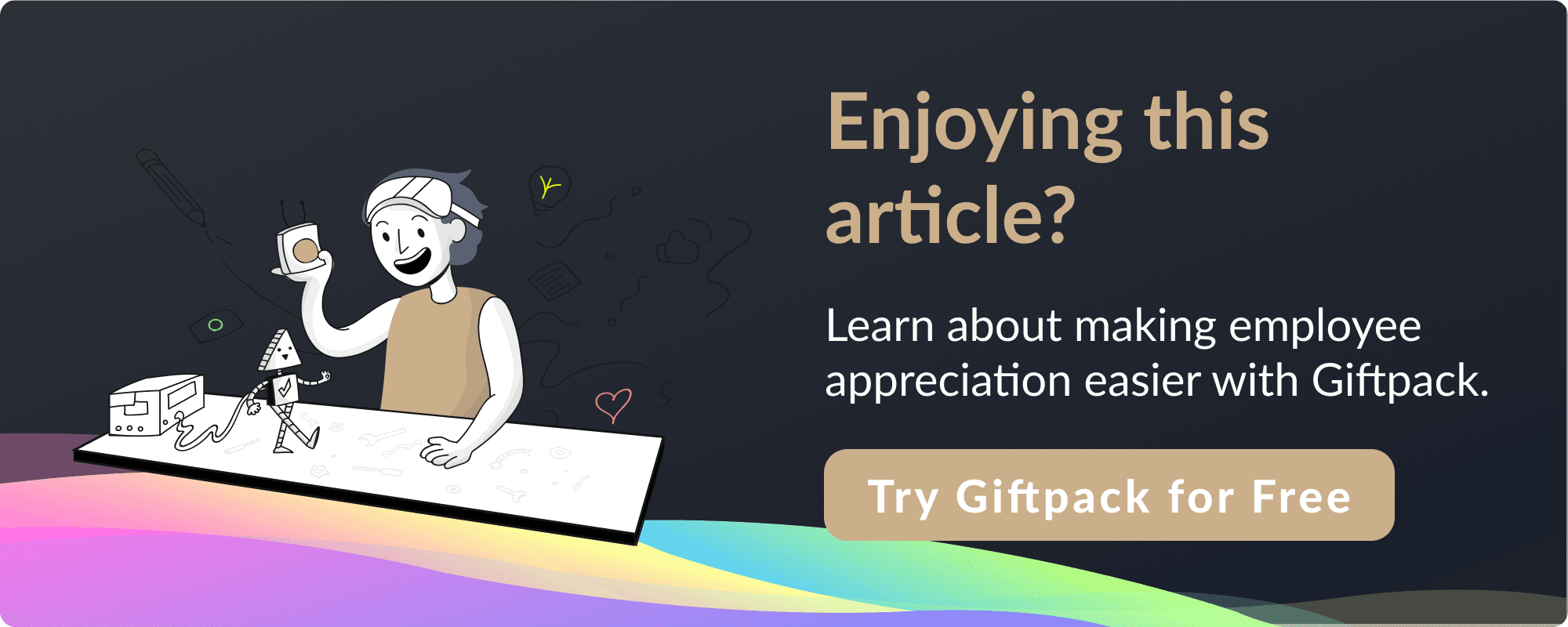
Welcome to our blog on employee rewards and recognition program examples! In today's competitive business landscape, companies are constantly searching for innovative ways to attract and retain top talent. One proven method that has gained significant popularity is implementing employee rewards and recognition programs. These programs not only boost employee morale and motivation but also foster a positive work culture and enhance overall productivity. We will explore a range of employee rewards and recognition program examples that are guaranteed to inspire and engage your workforce.
As the saying goes, a happy employee is a productive employee. And what better way to keep your employees happy than by acknowledging and appreciating their hard work? Employee recognition programs provide a platform for employers to celebrate and reward their employees' achievements, both big and small. From monetary incentives, such as bonuses and raises, to non-monetary rewards like public recognition and flexible work hours, the possibilities are endless when it comes to designing an effective employee rewards and recognition program. We will delve into a plethora of creative employee rewards and recognition program examples that will help you build a motivated and dedicated team.
So, whether you're a small start-up or a large corporate organization, this blog is your go-to resource for inspiration and guidance on implementing employee rewards and recognition programs. Join us as we explore various employee rewards and recognition program examples that have proven to boost employee satisfaction, foster loyalty, and drive success. Get ready to take your employee recognition efforts to the next level and unlock the full potential of your workforce!
What Is The Purpose of An Employee Rewards and Recognition Program?

In the world of business, organizations strive to create a productive and engaged workforce. One effective way to achieve this is through the implementation of an Employee Rewards and Recognition Program. This program serves as a powerful tool to acknowledge and appreciate the hard work and contributions of employees. Let's explore the primary purpose of such a program and how it benefits both employees and organizations.
Boosting Morale and Motivation: A Recipe for Success
One of the primary purposes of an Employee Rewards and Recognition Program is to boost morale and motivation within the organization. When employees feel valued and appreciated for their efforts, they are more likely to be engaged and committed to their work. Recognition for their achievements serves as a powerful motivator, inspiring them to continue performing at their best. By implementing such a program, organizations can create a positive and energized work environment that drives employee satisfaction and productivity.
Creating a Culture of Appreciation: An Essential Ingredient for Success
An Employee Rewards and Recognition Program helps organizations foster a culture of appreciation. When employees are acknowledged and praised for their hard work, it creates a ripple effect throughout the organization. Co-workers witness the recognition and are inspired to go above and beyond in their own roles. This creates a culture where achievements are celebrated, and individuals are encouraged to excel. A culture of appreciation enhances teamwork, collaboration, and overall employee satisfaction, leading to a more harmonious and successful organization.
Increasing Retention and Loyalty: The Secret Sauce for Employee Engagement
Employee turnover can be costly for organizations. An effective Employee Rewards and Recognition Program plays a vital role in increasing employee retention and loyalty. When employees feel valued and recognized, they are more likely to stay with the organization for the long term. This reduces recruitment and training costs while maintaining a stable and experienced workforce. A recognition program creates a sense of loyalty among employees, fostering a stronger bond between them and the organization. This, in turn, leads to increased employee engagement and commitment to achieving the organization's goals.
Driving Innovation and Performance: The Catalyst for Growth
Another significant benefit of an Employee Rewards and Recognition Program is its ability to drive innovation and performance. When employees receive recognition for their exceptional work, it encourages them to think outside the box and come up with creative solutions. Recognition serves as validation for their efforts, instilling confidence and empowering them to take risks. This, in turn, leads to improved productivity, higher quality of work, and ultimately, organizational growth.
An Employee Rewards and Recognition Program is not just a nice to have but an essential ingredient for organizational success. By boosting morale, creating a culture of appreciation, increasing retention, and driving innovation, such a program benefits both employees and organizations. So, take a moment to appreciate your employees, and watch them thrive, bringing your organization to new heights.
Related Reading
• How To Improve Employee Morale • How To Motivate Your Team • Benefits Of Employee Recognition • Why Is Employee Recognition Important • Employee Recognition Benefits • How To Improve Employee Satisfaction • Culture Of Recognition In The Workplace • Employee Recognition Statistics • Best Practices For Employee Recognition • Employee Anniversary Recognition
64 Exciting Employee Rewards and Recognition Program Examples

1. Wall of Fame
Create a designated area where you can display photos and achievements of top-performing employees. This visual recognition will inspire others to strive for greatness.
2. Employee Spotlight
Shine a spotlight on one employee each month, showcasing their accomplishments, skills, and personal interests. This highlights their unique contributions and fosters a sense of pride.
3. Peer-to-Peer Recognition
Encourage employees to recognize and appreciate each other's efforts by implementing a peer-to-peer recognition program. This builds a strong bond within the team and promotes a positive work culture.
4. Milestone Celebrations
Celebrate significant milestones in an employee's career or achievements, such as work anniversaries, reaching sales targets, or completing a challenging project. This shows appreciation for their dedication and hard work.
5. Flexible Work Options
Offer flexible work arrangements, such as remote work or flexible hours, as a reward for exceptional performance. This allows employees to achieve a better work-life balance, resulting in increased satisfaction and productivity.
6. Paid Time Off Awards
Recognize outstanding performance by granting additional paid time off to deserving employees. This gives them the opportunity to relax, recharge, and come back to work with renewed energy.
7. Learning and Development Opportunities
Provide employees with the chance to attend conferences, workshops, or online courses to enhance their skills and knowledge. Investing in their professional growth shows that you value their development.
8. Team Building Outings
Organize team-building activities or outings to reward and strengthen the bond between team members. This can include activities like escape rooms, outdoor adventures, or volunteer work.
9. Customized Workspaces
Allow employees to personalize their workspaces with items that reflect their personality and interests. This creates a sense of ownership and comfort, boosting morale and productivity.
10. Lunch with the CEO
Give employees the opportunity to have a one-on-one lunch with the CEO or other top executives as a reward for outstanding performance. This fosters a sense of importance and belonging within the company.
11. Wellness Programs
Implement wellness programs that promote physical and mental well-being, such as gym memberships, yoga classes, or meditation workshops. Prioritizing employee health contributes to a positive work environment.
12. Gamification
Introduce gamified elements into work processes or training programs. By turning tasks into challenges with rewards, employees are motivated to improve performance and achieve goals.
13. Professional Development Grants
Offer financial support for employees to pursue professional certifications or degrees related to their field. This investment in their career development shows commitment to their success.
14. Employee Referral Program
Encourage employees to refer potential candidates for open positions by offering referral bonuses. This taps into their network and helps attract top talent.
15. Recognition Emails
Send personalized emails to employees acknowledging their achievements and expressing gratitude for their hard work. This simple gesture goes a long way in boosting morale.
16. Innovation Challenges
Create innovation challenges where employees can submit ideas to improve processes, products, or services. Recognize and reward the best ideas, fostering a culture of innovation.
17. Health and Wellness Challenges
Organize health and wellness challenges, such as step competitions or healthy eating challenges. Recognize and reward employees who actively participate and achieve their goals.
18. Team Appreciation Events
Plan special team appreciation events, such as team lunches, happy hours, or outings. These events create a sense of camaraderie and allow team members to bond outside of work.
19. Leadership Development Programs
Identify high-potential employees and provide them with leadership development programs, coaching, and mentoring opportunities. This shows them that you believe in their potential and are invested in their growth.
20. Spot Bonuses
Surprise employees with on-the-spot bonuses for exceptional performance or going above and beyond. This spontaneous reward system encourages continuous excellence.
21. Family-Friendly Benefits
Offer family-friendly benefits such as childcare assistance, parental leave, or flexible work schedules for employees with families. This demonstrates understanding and support for work-life balance.
22. Employee Appreciation Week
Dedicate a week each year to celebrate and appreciate employees. Plan special activities, giveaways, and recognition events to make them feel valued.
23. Virtual Recognition Wall
Create a virtual recognition wall where employees can post messages of appreciation and recognition for their colleagues. This fosters a sense of community and encourages positive interactions.
24. Inspirational Speaker Series
Invite renowned speakers to share inspirational stories and insights with your employees. This motivational experience can ignite passion and drive among the team.
25. Customer Testimonial Program
Recognize employees who receive exceptional customer testimonials or reviews. Share these testimonials internally to highlight their outstanding service. You can take this recognition one step further and record these testimonials in the form of video reviews. Adding these video testimonials on your company's WordPress site can be done in a seamless way and it serves as a great vehicle for enhancing internal morale, while simultaneously boosting your external reputation. Not only does it instill a sense of pride in your employees, but it also provides validation for their hard work and dedication.
26. Personal Development Allowance
Provide employees with an allowance to spend on personal development resources, such as books, online courses, or coaching services. This encourages continuous learning and growth.
27. Annual Awards Ceremony
Host an annual awards ceremony to recognize outstanding employees across various categories, such as teamwork, innovation, customer service, and leadership. This creates a sense of healthy competition and inspires others to excel.
28. Employee of the Month Parking Spot
Designate a premium parking spot exclusively for the Employee of the Month. This coveted perk serves as a visible recognition of their exceptional performance.
29. Thank You Notes
Encourage managers and team members to write handwritten thank you notes to express appreciation for their colleagues' contributions. These personal gestures have a lasting impact.
30. Sabbatical Leave
Offer extended paid sabbatical leaves to employees who have been with the company for a certain period of time. This allows them to take a break and come back re-energized.
31. Team Challenges
Organize friendly team challenges, such as sports tournaments or trivia nights. Recognize the winning team and celebrate their achievements.
32. Career Coaching
Provide employees with access to career coaching or mentoring programs. This helps them navigate their career paths and develop their skills.
33. Volunteer Opportunities
Encourage employees to participate in volunteer activities and recognize their efforts through a dedicated volunteer recognition program. This fosters a sense of purpose and community engagement.
34. Professional Memberships
Cover the cost of professional memberships for employees to join industry associations or organizations. This allows them to network and stay updated with industry trends.
35. Breakfast with the Boss
Arrange breakfast meetings where employees have the opportunity to have an informal chat with the company's leaders. This promotes open communication and networking.
36. Monthly Team Outings
Organize monthly team outings to promote team bonding and boost morale. These can include activities like movie nights, bowling, or mini-golf.
37. Wellness Challenges
Implement wellness challenges where employees can track their progress in areas such as exercise, nutrition, or mindfulness. Recognize and reward those who achieve their personal goals.
38. Learning Lunches
Arrange lunchtime learning sessions where employees can share their knowledge and expertise with their colleagues. This promotes a culture of continuous learning and collaboration.
39. Performance-Based Bonuses
Tie bonuses directly to individual or team performance metrics. This aligns rewards with results and drives motivation.
40. Work Anniversary Celebrations
Celebrate employees' work anniversaries with personalized gifts or experiences that reflect their time with the company. This shows appreciation for their loyalty and commitment.
41. Employee Appreciation Cards
Create personalized recognition cards that employees can give to their colleagues to express appreciation for their help or support. This encourages a culture of gratitude.
42. Team Incentive Trips
Plan all-expenses-paid trips for high-performing teams as a reward for achieving significant milestones or surpassing targets. This creates unforgettable experiences and boosts team morale.
43. Skill Development Workshops
Offer workshops or training sessions on specific skills that are relevant to employees' roles or career aspirations. This investment in their professional growth shows commitment to their success.
44. Workplace Wellness Challenges
Organize workplace wellness challenges, such as step competitions or healthy recipe contests. Recognize and reward employees who actively participate and embrace a healthy lifestyle.
45. Employee Appreciation Notes
Encourage employees to write appreciation notes to their colleagues, recognizing their efforts and contributions. These notes can be shared publicly or privately and create a culture of gratitude.
46. Innovation Time
Dedicate a set amount of time each week or month for employees to work on innovative projects outside of their regular responsibilities. Recognize and reward the best ideas that emerge from these initiatives.
47. Learning Circles
Facilitate learning circles where employees can gather to discuss and share knowledge on specific topics of interest. This promotes continuous learning and collaboration.
48. Team Challenges
Organize team challenges that require collaboration and problem-solving skills. Recognize and reward the winning team, fostering healthy competition and team spirit.
49. Positive Feedback Wall
Create a physical or virtual wall where employees can post positive feedback they receive from clients, customers, or colleagues. This fosters a culture of recognition and positivity.
50. Employee Resource Groups
Support and recognize employee resource groups that promote diversity and inclusion. These groups provide a platform for employees to connect and share their unique experiences.
51. Leadership Shadowing
Give employees the opportunity to shadow senior leaders or executives for a day to gain insights into their roles and responsibilities. This encourages personal growth and aspiration.
52. Team Lunches
Organize team lunches where employees can bond and unwind. These casual gatherings provide an opportunity for teams to connect on a personal level.
53. Employee Development Plans
Create individual employee development plans that outline specific goals and milestones for career growth. Regularly review and recognize employees' progress towards these goals.
54. Recognition of Social Media Campaigns
Launch social media campaigns to recognize and appreciate employees' achievements. Share their success stories on platforms like LinkedIn, Twitter, or Instagram.
55. Learning Subscriptions
Provide employees with access to online learning platforms or subscriptions to industry-specific resources. This allows them to continuously expand their knowledge and skills.
56. Creative Flexibility
Offer employees the flexibility to explore their creative interests by working on passion projects or pursuing side businesses. This recognizes their unique talents and fosters a culture of innovation.
57. Gratitude Journals
Provide employees with gratitude journals to encourage daily reflection and appreciation. This cultivates a positive mindset and fosters a culture of gratitude.
58. Health Challenges
Organize health challenges focused on specific wellness goals, such as drinking more water or getting better sleep. Recognize and reward employees who actively participate and achieve their goals.
59. Skill Swapping
Encourage employees to share their skills and knowledge with their colleagues through skill-swapping sessions. This promotes cross-functional learning and collaboration.
60. Community Partnerships
Establish partnerships with local charities or nonprofit organizations and encourage employees to volunteer or participate in fundraising events. Recognize their efforts and impact on the community.
61. Employee Appreciation Mixtape
Create a customized playlist or mixtape for each employee to show appreciation for their unique contributions. This personal touch adds a fun and memorable element to recognition.
62. Health and Wellness Reimbursements
Offer reimbursements for fitness-related expenses, such as gym memberships, fitness classes, or wellness retreats. This encourages employees to prioritize their well-being.
63. Digital Badges
Introduce a digital badge system to recognize employees' achievements and skills. Employees can display these badges on their professional profiles, showcasing their expertise.
64. Annual Retreats
Plan annual retreats where employees can come together for team-building activities, workshops, and relaxation. These retreats provide an opportunity for employees to bond and rejuvenate.
The key to an impactful employee rewards and recognition program is to be consistent, personalized, and meaningful. Tailor these examples to fit your company culture and the unique preferences and needs of your employees.
Related Reading
• Employee Recognition Awards • Employee Recognition Examples • Employee Rewards And Recognition • Employee Recognition Letter • Employee Recognition Day • Employee Rewards Examples • Creative Employee Recognition Ideas • Employee Recognition Programs Examples • Recognition Examples For Employees • Examples Of Employee Recognition Awards • Employee Recognition Program Names • Types Of Employee Recognition • Employee Recognition Survey Questions • Employee Recognition Criteria • Employee Recognition Gifts • Employee Recognition Wall Ideas • Employee Recognition Gifts for Years of Service • Employee Recognition Points System • Virtual Employee Recognition Ideas
Innovative Trends in Employee Rewards and Recognition Programs for 2024

Employee rewards and recognition programs are evolving rapidly in 2024, embracing innovative approaches that cater to diverse workplaces. Staying ahead of these trends can help businesses maintain a motivated, engaged, and satisfied workforce.
One prominent trend is gamification in recognition programs. Incorporating elements like leaderboards, badges, and point systems transforms recognition into an engaging experience. Employees can “unlock” rewards through achievements, making the process fun and highly motivating.
Another game-changer is the use of AI-driven recognition platforms. These tools analyze performance data and provide personalized recommendations for recognizing employees. For instance, they might suggest rewarding an employee for completing a project ahead of schedule or for consistent collaboration within a team.
Eco-conscious rewards are gaining popularity as businesses align with sustainability values. Offering gifts made from recycled materials, contributions to environmental causes, or carbon-offsetting options shows employees and clients that the company values sustainability.
With the rise of remote and hybrid work environments, flexible reward models are becoming essential. Virtual gift cards, online subscriptions, and wellness app memberships ensure that both in-office and remote employees feel equally valued.
Non-monetary rewards, such as learning opportunities and flexible work arrangements, are also trending. Employees appreciate the recognition that supports their personal growth, like paid certifications, skill-building workshops, or additional leave days.
Finally, cultural appreciation initiatives are becoming integral. Celebrating employees’ cultural backgrounds through customized rewards or recognition during cultural events fosters inclusivity and strengthens team bonds.
These innovative trends make rewards and recognition programs effective and meaningful. By adopting these modern practices, businesses can keep their workforce inspired and connected. Platforms like Giftpack can simplify implementing these trends, offering tailored solutions for evolving workplace dynamics.

Create An Employee Rewards and Recognition Program With First Principles

When it comes to boosting employee morale and fostering a positive work environment, an effective Employee Rewards and Recognition Program is a game-changer. Such a program is not just about giving out rewards; it goes beyond that to create a culture of appreciation and acknowledgment. To create an optimal employee rewards and recognition program, there are key components and first principles that we must consider. Let's dive in and explore each of these elements in detail.
1. Clear Objectives and Goals: The Foundation for Success
At the core of any successful employee rewards and recognition program is a set of clear objectives and goals. These objectives should align with the company's overall mission and values. By defining what you want to achieve with the program, you can tailor the rewards and recognition to support those objectives. Whether it is promoting teamwork, boosting productivity, or enhancing employee engagement, having a clear vision will guide your program's success.
2. Meaningful and Personalized Recognition: Celebrating Individuality
One of the most important principles in designing an exceptional employee rewards and recognition program is to ensure that recognition is meaningful and personalized. It's not just about giving out generic rewards; it's about acknowledging the unique contributions of each employee. By personalizing recognition, you make it more impactful and genuine. Consider using handwritten notes, personalized messages, or customized rewards that align with the individual's interests and preferences. This level of personalization creates a deeper sense of appreciation and shows that their efforts are truly valued.
3. Timely and Regular Recognition: Strike While the Iron is Hot
Timing is everything when it comes to recognizing and rewarding employees. Delayed recognition loses its impact and may not have the desired effect. To create an optimal program, ensure that recognition is timely and regular. Celebrate achievements as soon as possible, whether it's a successful project completion, meeting a challenging goal, or displaying exceptional teamwork. Proactive and immediate recognition keeps employees motivated and engaged, making it more likely that they will continue to perform at their best.
4. Inclusive and Transparent: Level the Playing Field
An optimal employee rewards and recognition program should be inclusive and transparent, creating a level playing field for all employees. This means ensuring that everyone has an equal opportunity to be recognized and rewarded for their contributions. Avoid favoritism or bias and establish clear criteria for recognition. Consider incorporating peer-to-peer recognition, where employees can nominate and appreciate their colleagues. By embracing inclusivity and transparency, you foster a culture of fairness and create a sense of camaraderie among your employees.
5. Varied and Meaningful Rewards: Beyond Monetary Incentives
While monetary incentives are important, an exceptional employee rewards and recognition program goes beyond just cash rewards. It's about offering a variety of meaningful rewards that cater to the diverse interests and preferences of your employees. Consider options such as extra time off, professional development opportunities, team outings, or even small but thoughtful gestures like personalized gifts. By offering a range of rewards, you ensure that the program appeals to employees at all levels, driving motivation and engagement.
6. Continuous Feedback and Improvement: Evolving with Your Team
To create an optimal employee rewards and recognition program, it's crucial to embrace continuous feedback and improvement. Seek input from your employees and regularly evaluate the effectiveness of the program. Listen to their suggestions, understand their needs, and adapt accordingly. An ever-evolving program shows that you value their opinions and are committed to making the program better. By embracing feedback and continuously improving, you create a program that resonates with your team and drives sustainable results.
An exceptional employee rewards and recognition program is built on clear objectives, meaningful and personalized recognition, timely and regular appreciation, inclusivity and transparency, varied and meaningful rewards, and continuous feedback and improvement. By incorporating these key components and principles, you can create a program that not only rewards and recognizes employees but also fosters a positive and motivated work culture. So go ahead, create an exceptional program, and watch your team soar to new heights of success!
How To Design and Implement An Employee Rewards and Recognition Program

When designing and implementing an Employee Rewards and Recognition Program, it is crucial to start by understanding the company's culture and values. Company culture refers to the shared beliefs, values, attitudes, and behaviors that define an organization and its employees. By aligning the program with the company culture and values, it becomes more meaningful and impactful for the employees.
To begin, organizations should clearly articulate their core values and ensure that they are embedded in every aspect of the program. These values serve as guiding principles and help create a cohesive and consistent program. By integrating the values into the program, employees will feel a deeper sense of connection and purpose.
Discovering the Essence: Unveiling Employee Motivations
Understanding what motivates employees is another crucial step in designing a successful rewards and recognition program. Different individuals are driven by various factors, including financial incentives, public recognition, personal development, or work-life balance. By uncovering these motivations, organizations can tailor the program to meet the diverse needs of their workforce.
Consider conducting surveys, focus groups, or one-on-one interviews to gather insights about employee preferences. This information will provide valuable guidance in structuring the program and selecting appropriate rewards and recognition initiatives that resonate with employees.
Creating a Balanced Program
A well-designed rewards and recognition program strikes a balance between monetary and non-monetary rewards. While financial incentives are important, non-monetary rewards can be equally powerful in fostering employee engagement and loyalty. Examples of non-monetary rewards include flexible work arrangements, professional development opportunities, and public recognition.
By offering a mix of both types of rewards, organizations can cater to the diverse needs and preferences of their employees. This ensures that the program remains inclusive and accessible to everyone, regardless of their financial situation or personal preferences.
Timing is Everything: Frequency and Timeliness of Recognition
The frequency and timeliness of recognition are key factors in the success of a rewards and recognition program. Employees want to feel appreciated and valued in real-time, rather than waiting for an annual or quarterly recognition event. Therefore, it is essential to incorporate regular and timely recognition into the program.
Consider implementing a system where employees can give and receive recognition on an ongoing basis. This can be done through peer-to-peer recognition platforms, monthly or weekly team meetings dedicated to recognizing achievements, or a public recognition board where employees can acknowledge their colleagues' accomplishments.
Sustainability and Continuous Improvement
To ensure the long-term success of an Employee Rewards and Recognition Program, it is important to build sustainability into its design. Sustainability refers to the program's ability to adapt and evolve with the changing needs of the organization and its employees.
Regularly review and evaluate the program's effectiveness by collecting feedback from employees and monitoring key metrics such as employee satisfaction, retention rates, and productivity. Use this data to make informed decisions and continuously improve the program over time.
Celebrating Milestones: Program Evaluation and Milestone Celebrations
As the program evolves, it is essential to celebrate milestones and achievements along the way. This not only recognizes the progress made but also serves as a motivator for employees to continue their engagement with the program. Plan milestone celebrations, such as anniversaries of the program's launch or reaching specific participation milestones, to acknowledge the program's impact and show appreciation for everyone's efforts.
By celebrating milestones, organizations reinforce the importance of the program and create a sense of pride and accomplishment among employees.
Designing and implementing an Employee Rewards and Recognition Program that aligns with company culture and values requires a thoughtful and strategic approach. By understanding the company's culture, uncovering employee motivations, creating a balanced program, and ensuring sustainability and continuous improvement, organizations can create a program that fosters employee engagement, loyalty, and recognition.
How Employee Rewards and Recognition Program Initiatives Boost Overall Job Satisfaction

Employee morale and motivation play a significant role in the success of any organization. When employees feel appreciated and recognized for their hard work and contributions, they are more likely to be motivated, engaged, and satisfied with their jobs. This is where employee rewards and recognition programs come into play. By implementing effective programs, organizations can boost employee morale, motivation, and overall job satisfaction. Let's explore how this can be achieved.
Recognizing Achievement: Fostering Employee Morale
Recognition is a powerful tool that can positively impact employee morale. When employees receive recognition for their achievements and efforts, they feel valued and appreciated. This recognition serves as a validation of their hard work and dedication, boosting their confidence and morale. Whether it's through verbal praise, certificates, or public acknowledgments, employee rewards and recognition programs can create a culture of appreciation, making employees feel motivated to continue performing at their best.
Motivation through Rewards: Driving Performance and Job Satisfaction
Rewards are a tangible way to motivate employees and drive performance. When employees know that their hard work will be rewarded, they become more motivated to achieve their goals and exceed expectations. Employee rewards and recognition programs can offer various incentives, such as bonuses, gift cards, or extra time off, to recognize outstanding performance. These rewards not only provide a sense of accomplishment and motivation but also contribute to overall job satisfaction and employee retention.
Creating a Positive Work Environment: Enhancing Job Satisfaction
A positive work environment is crucial for employee job satisfaction. Employee rewards and recognition programs help create this positive environment by fostering a culture of appreciation and engagement. When employees feel valued and recognized, they are more likely to be satisfied with their jobs and have a higher level of commitment to their organization. By implementing these programs, organizations can create a supportive and encouraging workplace, leading to increased job satisfaction and reduced turnover rates.
Promoting Collaboration and Teamwork: Strengthening Employee Morale and Motivation
Employee rewards and recognition programs can also promote collaboration and teamwork within an organization. By recognizing and rewarding team efforts, these programs encourage employees to work together towards common goals. This collaboration not only enhances employee morale and motivation but also improves overall job satisfaction. When employees feel like they are part of a cohesive team, they are more likely to be engaged, productive, and satisfied with their work.
Personal and Professional Growth: Boosting Job Satisfaction and Motivation
Employee rewards and recognition programs can also contribute to personal and professional growth. By acknowledging and rewarding employees' accomplishments, organizations encourage continuous learning and development. When employees see that their efforts are recognized and rewarded, they are motivated to further enhance their skills and knowledge. This personal and professional growth leads to increased job satisfaction, as employees feel challenged, valued, and supported in their career progression.
Employee rewards and recognition programs have a significant impact on boosting employee morale, motivation, and overall job satisfaction. By fostering a culture of appreciation, offering tangible rewards, creating a positive work environment, promoting collaboration, and supporting personal and professional growth, organizations can create a motivated and satisfied workforce. With the right rewards and recognition programs in place, organizations can unlock the full potential of their employees and drive success.
The Importance of Getting Feedback From Your Team About Your Employee Rewards and Recognition Program

In the world of employee rewards and recognition programs, feedback plays a crucial role in driving success and effectiveness. Providing regular feedback to employees helps them understand the expectations, align their goals, and improve their performance. It serves as a guiding light, providing employees with actionable insights on how to improve their skills and contribute to the overall success of the organization.
But how can feedback be integrated effectively into these programs? Let's dive into some strategies and best practices.
1. Ongoing Feedback
Incorporating feedback into employee rewards and recognition programs should not be a one-time event. It needs to be an ongoing process, with regular check-ins and conversations between managers and employees. This allows for continuous improvement and ensures that employees have a clear understanding of their performance and areas for development.
2. Constructive Criticism
Feedback should focus on constructive criticism rather than being overly critical. It's important to strike a balance between highlighting areas for improvement and recognizing achievements. By framing feedback in a positive and constructive manner, employees are more likely to be receptive to it and motivated to make the necessary improvements.
3. Goal Alignment
Feedback should be tied to the goals and objectives of the organization and individual employees. This helps employees understand how their performance contributes to the overall success of the company. When feedback is aligned with goals, it becomes more meaningful and serves as a motivator for employees to achieve higher levels of performance.
Performance Evaluation: The Foundation of Employee Rewards and Recognition Programs
Performance evaluation is the foundation on which employee rewards and recognition programs are built. It provides a systematic way to assess employee performance and determine eligibility for rewards and recognition. It is essential to approach performance evaluation with fairness and transparency to ensure its effectiveness.
Here are some key considerations for integrating performance evaluations into rewards and recognition programs effectively:
1. Clear Criteria
Performance evaluations should have clear and objective criteria that are aligned with job responsibilities and organizational goals. This helps ensure consistency and fairness in the evaluation process. Employees should know what is expected of them and how their performance will be measured.
2. Regular Checkpoints
Instead of relying solely on an annual performance review, consider incorporating regular checkpoints throughout the year. This allows for timely feedback and course correction, rather than waiting until the end of the year to address performance issues. Regular check-ins help keep employees engaged and motivated to improve their performance.
3. Two-Way Communication
Performance evaluations should not be a one-way conversation. Encourage employees to provide their input and self-assessment during the evaluation process. This helps foster a sense of ownership and allows employees to have a voice in their performance evaluation. It also provides an opportunity for managers to gain insights into the employee's perspective and challenges they may be facing.
By integrating feedback and performance evaluation effectively into employee rewards and recognition programs, organizations can create a culture of continuous improvement and motivation. Employees feel valued and appreciated, leading to higher levels of engagement and productivity. So, embrace the power of feedback and performance evaluation to drive the success of your employee rewards and recognition programs.
Best Practices for Measuring the ROI of Your Employee Rewards and Recognition Program

Creating an employee rewards and recognition program is a great way to boost employee morale and engagement. But how do you know if your program is effective? How do you measure the return on investment (ROI) of your efforts? We will explore some best practices for measuring the ROI of an employee rewards and recognition program and how organizations can gauge its effectiveness.
1. Establish clear goals and objectives
Before implementing an employee rewards and recognition program, it is important to establish clear goals and objectives. What do you hope to achieve with this program? Do you want to increase employee retention, improve productivity, or enhance company culture? By defining your goals, you can better determine the success of your program and measure its impact.
2. Collect and analyze relevant data
To measure the ROI of your employee rewards and recognition program, you need to collect and analyze relevant data. This can include employee engagement surveys, turnover rates, productivity metrics, and performance evaluations. By tracking these key indicators before and after implementing your program, you can compare the results and determine if there has been a positive impact.
3. Calculate the financial impact
In addition to qualitative data, it is important to calculate the financial impact of your employee rewards and recognition program. This can include assessing the cost of rewards and incentives, as well as calculating the return on investment based on the outcomes achieved. For example, if your program leads to a decrease in turnover and recruitment costs, you can calculate the savings and compare it to the cost of running the program.
4. Seek feedback from employees
One of the most valuable sources of information when measuring the effectiveness of your employee rewards and recognition program is the feedback from your employees. Conduct surveys or focus groups to gather their opinions and insights. Are they satisfied with the program? Do they feel recognized and appreciated? By listening to their feedback, you can make necessary adjustments and improvements to enhance the program's impact.
5. Regularly review and adjust your program
Measuring the ROI of an employee rewards and recognition program is an ongoing process. It is important to regularly review and adjust your program based on the data and feedback you receive. By continuously monitoring the program's effectiveness, you can make informed decisions and optimize its impact on employee engagement and overall business performance.
Measuring the ROI of an employee rewards and recognition program is essential for organizations to understand the impact of their efforts. By establishing clear goals, collecting and analyzing relevant data, calculating the financial impact, seeking feedback from employees, and regularly reviewing and adjusting the program, organizations can gauge its effectiveness and make informed decisions to enhance employee engagement and drive business success.
Potential Challenges You May Encounter & How To Mitigate Them

Implementing employee rewards and recognition programs can be a powerful tool to boost employee morale, motivation, and engagement. Like any organizational initiative, there are potential challenges and obstacles that organizations may face when implementing these programs. We will explore some of these challenges and provide strategies to overcome them.
1. Lack of Clarity and Communication
One common challenge is a lack of clarity and communication about the goals and objectives of the rewards and recognition program. This can lead to confusion among employees and hinder their participation and engagement.
Solution
It is crucial for organizations to clearly define the purpose and goals of the program and effectively communicate them to employees. This can be done through regular updates, town hall meetings, and email communications. Providing training and resources to managers on how to effectively implement the program can help ensure consistent messaging and understanding.
2. Inadequate Program Design
Another challenge organizations may face is an inadequate program design. This could include a lack of variety in the types of rewards and recognition offered, or a failure to align the program with the values and culture of the organization.
Solution
Organizations should take the time to carefully design the program, ensuring that it aligns with their values and culture. This can be done by involving employees in the process through focus groups or surveys to gather their input and preferences. Offering a variety of rewards and recognition options that cater to different preferences and interests can help increase engagement and participation.
3. Lack of Consistency and Fairness
Maintaining consistency and fairness in the implementation of the rewards and recognition program can be a challenge. If certain employees or teams consistently receive more recognition or rewards than others, it can create feelings of resentment and demotivation.
Solution
Organizations should establish clear criteria and guidelines for how employees are selected for recognition and rewards. This can include specific performance metrics or behaviors that align with the organization's goals and values. Ensuring that managers consistently and fairly apply these criteria can help create a culture of fairness and equity.
4. Lack of Managerial Support
A lack of support or buy-in from managers can undermine the success of an employee rewards and recognition program. If managers do not prioritize recognition or fail to provide timely and meaningful feedback, employees may feel that their efforts are not valued.
Solution
It is crucial for organizations to provide training and resources to managers on the importance of recognition and how to effectively provide it. This can include workshops, coaching sessions, or even incorporating recognition into performance management processes. Holding managers accountable for recognizing and rewarding employees can help ensure their active participation and support.
Implementing employee rewards and recognition programs can be a valuable strategy to boost employee engagement and motivation. By addressing potential challenges and obstacles, organizations can maximize the effectiveness of these programs and create a positive and rewarding work culture.
Creating A Cohesive Work Culture

Employee engagement is a key factor in driving productivity, job satisfaction, and overall success within an organization. While there are various strategies that can be employed to enhance employee engagement, integrating employee rewards and recognition programs can significantly contribute to creating a cohesive and supportive workplace culture. Let's explore how these programs can be aligned with broader employee engagement strategies.
1. Aligning Rewards and Recognition Programs with Company Values and Goals
To foster a strong workplace culture, it is essential to align rewards and recognition programs with the company's values and goals. When employees feel that their contributions are valued and aligned with the organization's mission, they are more likely to be engaged and motivated. For example, an employee rewards program can include recognition for behaviors that align with the company's core values, such as teamwork, innovation, or customer service excellence.
2. Making Rewards and Recognition Program Transparent and Inclusive
Transparency and inclusivity are vital elements in creating a cohesive workplace culture. Employees should be aware of the criteria for receiving rewards and recognition, as well as the process for nominating or selecting recipients. This transparency ensures fairness and encourages all employees to strive for excellence. The program should be inclusive, recognizing achievements at all levels of the organization and across various departments. This inclusivity promotes a sense of unity and encourages collaboration.
3. Incorporating Employee Feedback and Input
Engaging employees in the process of designing and implementing rewards and recognition programs can significantly enhance their effectiveness. By soliciting employee feedback and input, organizations can gain insight into the types of rewards and recognition that are most meaningful and motivating to their workforce. This approach demonstrates that the organization values and respects the opinions of its employees, further strengthening their engagement and commitment.
4. Providing Personalized and Meaningful Rewards
One size does not fit all when it comes to rewards and recognition. To create a supportive workplace culture, it is important to offer personalized and meaningful rewards that resonate with individual employees. This can be achieved by considering employees' preferences, interests, and aspirations when designing the rewards and recognition program. Whether it's a gift, a monetary incentive, or a professional development opportunity, tailoring the rewards to each employee's needs and desires demonstrates a genuine appreciation for their contributions.
5. Celebrating Milestones and Achievements
Recognizing and celebrating employee milestones and achievements is a powerful way to reinforce a supportive workplace culture. Whether it's a promotion, completing a challenging project, or reaching a significant sales target, acknowledging these accomplishments publicly not only boosts the morale of the individual but also inspires others to strive for greatness. By creating a culture of celebration, organizations can foster a sense of pride, motivation, and camaraderie among their employees.
Integrating employee rewards and recognition programs within broader employee engagement strategies is crucial for creating a cohesive and supportive workplace culture. By aligning programs with company values, being transparent and inclusive, incorporating employee feedback, providing personalized rewards, and celebrating achievements, organizations can cultivate an environment where employees feel valued, motivated, and engaged.
Find Meaningful Corporate Gifts for Employees With Ease with Giftpack

At Giftpack, we understand that finding the perfect gift for someone can be an overwhelming task. With so many options to choose from and each individual having their own unique preferences, it can feel like an endless search for that one special gift. That's where we come in.
Our mission at Giftpack is to simplify the corporate gifting process while maximizing the impact of each gift. We have created a platform that utilizes our custom AI algorithm to create highly customized scenario swag box options for you. Whether you need to reward your employees, impress your clients, or surprise your loved ones, we've got you covered.
Global Delivery at Your Fingertips
One of the standout features of Giftpack is our global delivery service. No matter where you or your recipients are located, we ensure that your gifts are delivered with care. We have partnered with trusted logistics providers all over the world to make sure that every gift reaches its destination in a timely manner.
A Vast Catalog of Thoughtful Gifts
With over 3.5 million products in our catalog, we have something for everyone. Whether you're looking for personalized items, luxury goods, or practical everyday essentials, we've got it all. Our team carefully curates the most fitting gifts based on an individual's basic demographics, preferences, social media activity, and digital footprint. This ensures that the gift selection process is tailored to each recipient, no matter who they are.
Meaningful Connections Across the Globe
At Giftpack, we believe in the power of personalized gifting to create meaningful connections. Whether you're rewarding your hardworking employees, showing appreciation to your loyal customers, or surprising your friends and family, our platform makes it easy and accessible to send thoughtful gifts on a large scale. We source gifts from both local and global suppliers to ensure that your gift is not only personalized but also represents different cultures and traditions from around the world.
A User-Friendly Experience
We know that time is valuable, especially in the fast-paced business world. That's why we have created a user-friendly platform that makes the gift selection process quick and easy. Our intuitive interface allows you to browse through our extensive catalog, view personalized gift recommendations, and place orders with just a few clicks. Say goodbye to the days of spending hours searching for the perfect gift - with Giftpack, it's as simple as a few swipes and clicks.
Innovation at the Heart of Giftpack
We are constantly evolving and pushing the boundaries of what is possible in the world of corporate gifting. Our team is always on the lookout for new and exciting gift ideas to add to our catalog. From the latest tech gadgets to unique artisanal products, we strive to offer a wide range of options to suit every taste and occasion. With Giftpack, you can be sure that you're giving a gift that stands out and leaves a lasting impression.
Giftpack is revolutionizing the corporate gifting experience. Our platform simplifies the gift selection process, offers global delivery options, and curates personalized gifts from a vast catalog. With Giftpack, you can create meaningful connections and show your appreciation to employees, clients, and loved ones with ease. So why settle for generic gifts when you can make a lasting impression with Giftpack? Start exploring our platform today and elevate your gifting game to new heights.
Related Reading
• Employee Recognition Cards • Employee Recognition Program Guidelines • Employee Recognition Companies • Employee Recognition Software • Employee Recognition Platform • Recognition Email To Employee • Gift Cards For Employee Recognition
Make your gifting efficient and improve employee attrition rates with Giftpack AI
Visit our product page to unlock the power of personalized employee appreciation gifts.